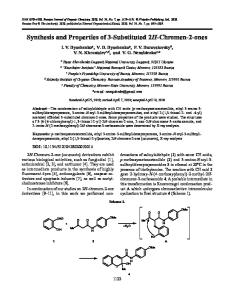Comparison of the Anticonvulsant Activities of Substituted Hydroxycoumarins and 4-[(3-Nitro-2-Oxo-2 H -Chromen-4-Yl)Amin
- PDF / 143,989 Bytes
- 5 Pages / 594 x 792 pts Page_size
- 53 Downloads / 285 Views
Pharmaceutical Chemistry Journal, Vol. 54, No. 9, December, 2020 (Russian Original Vol. 54, No. 9, September, 2020)
COMPARISON OF THE ANTICONVULSANT ACTIVITIES OF SUBSTITUTED HYDROXYCOUMARINS AND 4-[(3-NITRO-2OXO-2H-CHROMEN-4-YL)AMINO]BUTANOIC ACID E. E. Yakovleva,1,* L. V. Myznikov,1 and P. D. Shabanov1 Translated from Khimiko-Farmatsevticheskii Zhurnal, Vol. 54, No. 9, pp. 22 – 26, September, 2020.
Original article submitted February 7, 2020. The anticonvulsant activity of hydroxycoumarin derivatives and 4-[(3-nitro-2-oxo-2H-chromen-4-yl)amino]butanoic acid was studied using nicotine and corazole convulsion models. All investigated compounds protected animals from death in 100% of cases after intraperitoneal administration of the LD50 of nicotine (14 mg/kg). 4-[(3-Nitro-2-oxo-2H-chromen-4-yl)amino]butanoic acid showed anticonvulsant activity at a dose of 20 mg/kg in the corazole convulsion test while 7-(2-morpholino-2-oxoethoxy)-2H-chromen-2-one (a 7-hydroxycoumarin derivative) prevented convulsions at a dose of 200 mg/kg, which was comparable to the anticonvulsant effect of valproic acid at the same dose. An analysis of the results suggested different mechanisms for the anticonvulsant action of the investigated substances, which was indicative of good prospects for further development of coumarin derivatives as agents with wide spectra of anticonvulsant activity. Keywords: coumarin derivatives, anticonvulsant activity, nicotine convulsions, corazole convulsions, mice.
Epilepsy is one of the most common neurological diseases. The overall incidence of this disease is 0.5 – 1.0% of the population, which numbers 50 million people worldwide [1, 2]. Remission with existing pharmacotherapy is achieved in only 70 – 80% of patients. Anticonvulsants used clinically are derivatives of 3,4-benzodiazepine; barbituric, thiobarbituric, and valproic acids; and other classes and cause numerous side effects [3 – 8]. Considering that patients suffering from epilepsy must take anticonvulsant agents for many years, the development of new effective and safe drugs remains a crucial problem [9, 10]. The basic development strategy for these drugs consists of discovering compounds with new mechanisms of action. Coumarin (chromen-2-one) derivatives are known to exhibit sedative, tranquilizing, and anticonvulsant properties [11, 12]. The anticonvulsant effect of coumarins was proposed to be associated with the effects of these compounds on g-aminobutyric acid (GABA) ionotropic receptors. Recent research found a significant synergistic effect upon coadmi1 *
nistration of coumarins and known anticonvulsant drugs used in clinical practice. Higher toxicity was a characteristic feature of chromen2-one derivatives without substituents on the phenyl ring as compared to umbelliferone derivatives, i.e., naturally occurring coumarins with a 7-OH group (Fig. 1) [13, 14]. Therefore, umbelliferone derivatives are attractive subjects for new anticonvulsant drug development. Umbelliferone itself exhibits weak anticonvulsant properties [12]. However,
Data Loading...






